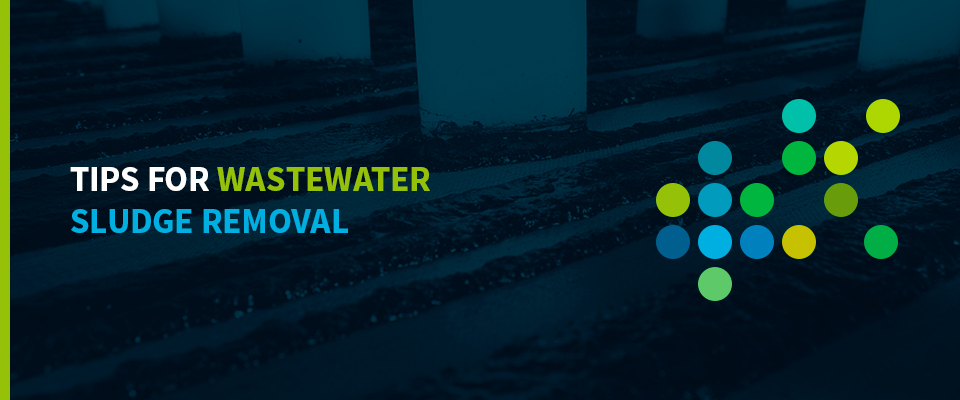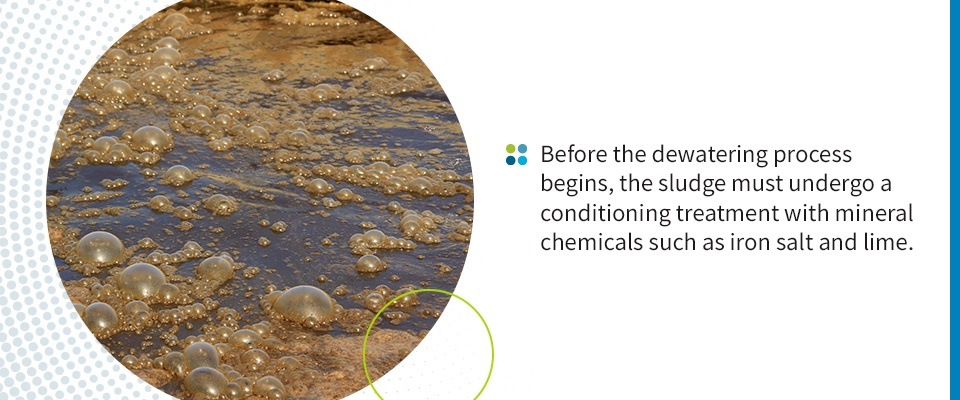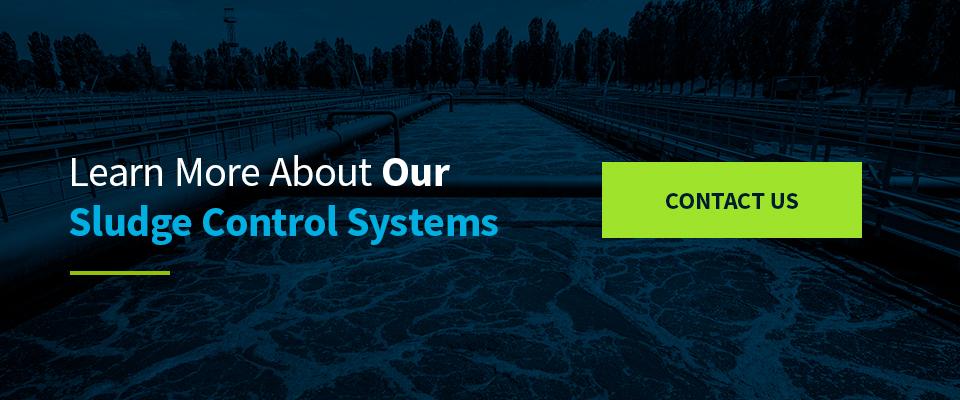Tips for Wastewater Sludge Removal
By: Tom Frankel
Post Date: febrero 9th 2022

Before 1950, it was common for many communities in the United States to discharge their untreated wastewater into local streams and rivers. As the water quality began to deteriorate as a result, the government passed the Clean Water Act. The act led to the development of wastewater treatment facilities, which then created a new material — wastewater sludge.
Table Of Contents
- What Is Wastewater Sludge?
- Types of Wastewater Sludge
- Why Sludge Removal Is Necessary
- How to Prepare Sludge for Removal
- The Sludge Thickening and Dewatering Process
- Dewatering Process
- How to Dispose of Wastewater Sludge
- Uses of Wastewater Sludge
- Learn More About Our Sludge Control Systems
What Is Wastewater Sludge?
Wastewater sludge is a semisolid waste or residue byproduct of wastewater treatment. This product contains organic and inorganic materials, plant nutrients, organic chemicals and pathogens, making proper sludge management in water treatment essential to minimize negative environmental impacts.
Types of Wastewater Sludge
The type of sludge produced depends upon the source and its use. The four types of sludge are:
- Drinking water sludge: This sludge is the byproduct of drinking water treatment facilities and is nonhazardous.
- Fecal sludge: Fecal sludge contains human excreta, solid wastes, urine and other materials found in sanitation systems.
- Industrial wastewater sludge: The byproduct of warehouses and manufacturing operations, industrial wastewater sludge is highly hazardous for humans and the environment due to the high levels of heavy metals and pathogens present.
- Sewage sludge: Sewage sludge is a byproduct of industrial wastewater or sewage treatment processes and contains organic and inorganic matter.
Why Sludge Removal Is Necessary
Wastewater sludge contains many dangerous pathogens that must be properly removed to preserve the water quality. Before wastewater can undergo sludge removal, it must be treated to reduce the sludge volume and stabilize the organic materials. Stabilizing sludge before removal reduces any harsh smells and makes it a safer material for storage and disposal.
How to Prepare Sludge for Removal
During the preparation process for removing wastewater, waterborne contaminants separate into a concentrated stream. There is often too much of this sludge line wastewater to dispose of it directly, so it requires additional processes to prepare for proper sludge treatment and disposal.
The Sludge Thickening and Dewatering Process
Sludge thickening and dewatering is critical to minimize water waste and turn the sludge back into a useable product. Failure to thicken the sludge will create excess waste and increase its potential to reenter the water system and cause pollution.
Stabilization and Digestion
The sludge stabilization treatment technique will reduce the sludge’s odor and toxic properties, and it has the side effect of reducing the volume of waste. This process includes lime treatment, anaerobic and aerobic digestion.
Anaerobic Digestion
The anaerobic digestion process occurs in an enclosed tank, where the sludge will experience a reduction in volume by converting the biomass to gases such as methane and carbon dioxide.
Aerobic Digestion
Aerobic digestion occurs in an open tank to oxidize biodegradable matter. During this process, the volume of sludge solids will decrease as the sludge stabilizes. Unlike the anaerobic digestion process, the aerobic digestion process does not release methane.
Lime Treatment
During a lime treatment process, the sludge will increase in mass. Adding lime allows the sludge to maintain a pH balance of 11.0 to remove most bacteria present in the organic matter.
Sludge Conditioning
The sludge conditioning process improves the dewatering conditions of the sludge. During chemical conditioning, the sludge combines with organic and inorganic chemicals. The thermal conditioning process also involves heating the sludge under controlled conditions.
Dewatering Process

The dewatering process is essential for waste minimization and separates sludge into solids and liquids. Before the dewatering process begins, the sludge must undergo a conditioning treatment with mineral chemicals such as iron salt and lime. After this treatment, the sludge thickens and is then dewatered for disposal.
It’s important to note that the dewatering process does not treat the solids and liquids produced but rather separates them for disposal. After dewatering, the solid and liquid components will need to undergo additional treatment to remove contaminants.
Belt Filter Press
In a belt filter press, two tensioned, porous belts enclose the sludge on either side before passing it over and under rollers of various sizes to squeeze out water.
Polymer Conditioning Unit
A polymer conditioning unit is a small tank with a rotating drum on top. The polymer conditioning unit will typically work in conjunction with the belt filter press.
Gravity Drainage Zone
A gravity drainage zone is a flat belt that will dewater the sludge through the gravity drainage of free water. This process can also utilize plow blades for additional drainage support.
Centrifuges
Using centrifugal force will increase the sedimentation rate of any solid particles of sludge. The conveyor belt will pick up sludge and transport it to the rotating bowl to undergo a rapid dewatering process.
Plate and Frame Press
A plate and frame press consists of vertical plates in a frame with a fiber cloth on each side of the plates. When the sludge enters the unit, the plates press together to dewater the sludge.
Sludge Drying Bed
Sludge drying beds use a bed of sand and gravel to dewater sludge. There are underdrains throughout the system to collect any filtrates, which return to the wastewater plant for use.
How to Dispose of Wastewater Sludge
What constitutes proper wastewater sludge removal equipment will depend on government regulations such as the Resource Conservation and Recovery Act, plant location and the sludge’s characteristics. Sludge disposal methods include:
Reclamation of Sludge
Since proper wastewater sludge disposal can be costly, it’s important to evaluate factors such as energy value, mineral content, byproduct for markets and the raw mineral makeup. Some examples of reclamation include burning released gases in compressors and selling byproduct metallic salts to treat wastewater.
Sludge Incineration
Sludge incineration is a two-step process of drying and combustion. During the incineration process, organic materials such as carbon and nitrogen enter the atmosphere as byproducts, and inorganic materials become ash.
Land Application
Another option is to use sludge as a fertilizer or soil conditioner. Before using sludge on land, it’s important to consider the sustainability of this application and the types of crops growing.
Landfill
Putting sludge in a landfill is the most common disposal method. If using this method, be careful not to contaminate the local groundwater. Many states require landfill disposal sites to use impermeable liners to mitigate contamination risks.
Uses of Wastewater Sludge
Wastewater sludge has a variety of uses, such as:
- Agriculture: Treated sludge can be a fertilizer for gardening, forestry or parks.
- Soil erosion control: Sludge can retain high amounts of water, making it ideal for holding soil to prevent erosion.
- Landscaping: As sludge dries, it will become a part of the land, which makes it a viable resource for landscaping and accelerating the growth of plants.
- Alternative fuel: Using sludge in a cement kiln produces lower carbon dioxide emissions.
- Heating and cooking: The anaerobic digestion method releases methane, which can be an energy source for heating and cooking.
Learn More About Our Sludge Control Systems
SSI Aeration, Inc. is a global leader in designing and manufacturing equipment for wastewater treatment plants. Our sludge control systems and innovative wastewater treatment solutions will streamline your processes, maximize efficiency and help you meet environmental standards.
To learn more about SSI sludge control systems, contact one of our experts.

Mr. Frankel co-founded SSI in 1995 with experience in design and distribution of engineered systems. He is in charge of sales, marketing and operations in the company. Mr. Frankel holds multiple US patents related to diffusers. He is a graduate of Washington University in St. Louis.


